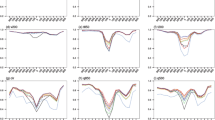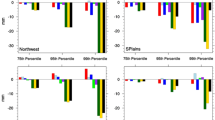Abstract
NOAA is accelerating its efforts to improve the numerical guidance and prediction capability for extended range (weeks 3 and 4) prediction in its seamless forecast system. Madden Julian Oscillation (MJO) is the dominant mode of sub-seasonal variability in tropics and prediction skill of MJO is investigated in this paper. We used different configurations of the NCEP Global Ensemble Forecast System (GEFS) to perform the experiments. The configurations include (1) the operational version of the stochastic perturbation forced with operational Sea Surface Temperatures (SSTs); (2) an updated stochastic physics forced with operational SSTs; (3) an updated stochastic physics forced with bias-corrected SSTs that are from Climate Forecast System (Version 2); and (4) as in (3) but with the addition of a scale aware-convection scheme. We evaluated MJO prediction skill from the experiments using Wheeler–Hendon indices and also examined the performance of the forecast system on prediction of key MJO components. We found that using the updated stochastic scheme improved the MJO prediction lead-time by about 4 days. Further updating the underlying SSTs with the bias corrected CFSv2 forecast increased the MJO prediction lead time by another 1.7 days. The best configuration of the four experiments is the last configuration which extends forecast lead time by ~ 9 days. Further investigation shows that upper and lower level zonal wind over the tropics has larger improvement than the outgoing longwave radiation (OLR). The improvement of the MJO prediction skill appears to be related primarily to the improvement in the representation associated circulations and OLR over the tropical West Pacific.










b and e are from Fig.7a and b in Zhu et al. 2018


Similar content being viewed by others
References
Arakawa A, Schubert WH (1974) Interaction of a cumulus cloud ensemble with the large-scale environment, Part I. J Atmos Sci 31(3):674–701
Berner J, Shutts GJ, Leutbecher M, Palmer TN (2009) A spectral stochastic kinetic energy backscatter scheme and its impact on flow-dependent predictability in the ECMWF ensemble prediction system. J Atmos Sci 66(3):603–626
Buizza R, Milleer M, Palmer T (1999) Stochastic representation of model uncertainties in 504 the ECMWF ensemble prediction system. Q J R Meteorol Soc 125(560):2887–2908
Ferranti L, Palmer TN, Molteni F, Klinker K (1990) Tropical-extratropical interaction associated with the 30–60 day oscillation and its impact on medium and extended range prediction. J Atmos Sci 47:2177–2199
Fu X, Lee J-Y, Hsu P-C, Taniguchi H, Wang B, Wang W, Weaver S (2013) Multi-model MJO forecasting during DYNAMO/CINDY period. Clim Dyn 41:1067–1081. https://doi.org/10.1007/s00382-013-1859-9
Gemmill W, Katz B, Li X (2007) Daily real-time, global sea surface temperature-high-resolution analysis: RTG_SST_HR. NCEP Office Note, #260, pp 1–39. http://polar.ncep.noaa.gov/mmab/papers/tn260/MMAB260.pdf
Gottschalck J et al (2010) A framework for assessing operational Madden–Julian oscillation forecasts: a CLIVAR MJO working group project. Bull Am Meteor Soc 91:1247–1258. https://doi.org/10.1175/2010BAMS2816.1
Grell G (1993) Prognostic evaluation of assumptions used by cumulus parameterizations. Mon Weather Rev 121(3):764–787 (2016/03/25)
Han J, Pan H-L (2011) Revision of convection and vertical diffusion schemes in the ncep global forecast system. Weather Forecast 26(4):520–533 (2016/03/25)
Han J, Wang W, Kwon Y, Hong S, Tallapragada V, Yang F (2017) Updates in the NCEP GFS cumulus convection schemes with scale and aerosol awareness. Weather Forecast 32:2005–2017
Hou D, Toth Z, Zhu Y (2006) A stochastic parameterization scheme within NCEP Global Ensemble Forecast System. In: Preprints, 18th Conf. on Probability and Statistics, Atlanta, GA, Amer. Meteor. Soc., p 4.5
Hou D, Toth Z, Zhu Y, Yang W (2008) Impact of a stochastic perturbation scheme on NCEP Global Ensemble Forecast System. In: Preprints, 19th Conf. on Probability and Statistics, New Orleans, LA, Amer. Meteor. Soc., p 1.1
Hudson D, Marshall AG, Yin Y, Alves O, Hendon H (2013) Improving intraseasonal prediction with a new ensemble generation strategy. Mon Weather Rev 141:4429–4449. https://doi.org/10.1175/MWR-D-13-00059.1
Johnson NC, Collins D, Feldstein S, L’Heureux M, Riddle E (2014) Skillful wintertime North American temperature forecasts out to 4 weeks based on the state of ENSO and the MJO. Weather Forecast 29:23–38. https://doi.org/10.1175/WAF-D-13-00102.1
Leutbecher M, Lock SJ, Ollinaho P, Lang STK, Balsamo G, Bechtold P, Bonavita M, Christensen HM, Diamantakis M, Dutra E, English S, Fisher M, Forbes RM, Goddard J, Haiden T, Hogan RJ, Juricke S, Lawrence H, MacLeod D, Magnusson L, Malardel S, Massart S, Sandu I, Smolarkiewicz PK, Subramanian A, Vitart F, Wedi N, Weisheimer A (2017) Stochastic representations of model uncertainties at ECMWF: state of the art and future vision. Q J R Meteorol Soc 143(707):2315–2339. https://doi.org/10.1002/qj.3094
Li C, Jia X, Ling J, Zhou W, Zhang C (2009) Sensitivity of MJO simulations to convective heating profiles. Clim Dyn 32:167–187
Lin H, Brunet G (2009) The influence of the Madden–Julian oscillation on Canadian wintertime surface air temperature. Mon Weather Rev 137:2250–2262
Lin JL, Lee MI, Kim D, Kang IS, Frierson DMW (2008) The impacts of convective parameterization and moisture triggering on AGCM-simulated convectively coupled equatorial waves. J Clim 21:883–909
Liu P, Wang B, Sperber KR, Li T, Meehl GA (2005) MJO in the NCAR CAM2 with the Tiedtke convective scheme. J Clim 18:3007–3020. https://doi.org/10.1175/JCLI3458.1
Liu X et al (2016) MJO prediction using the sub-seasonal to seasonal forecast model of Beijing Climate Center. Clim Dyn. https://doi.org/10.1007/s00382-016-3264-7
Liu et al (2017) MJO prediction using the sub-seasonal to seasonal forecast model of Beijing Climate Center. Clim Dyn 48:3283–3307
Ma J, Zhu Y, Wobus D, Wang P (2012) An effective configuration of ensemble size and horizontal resolution for the NCEP GEFS. Adv Atmos Sci 29(4):782–794
Maloney ED, Hartmann DL (2001) The sensitivity of intraseasonal variability in the NCAR CCM3 to changes in convective parameterization. J Clim 14:2015–2034
Neena JM, Lee JY, Waliser D, Wang B, Jiang X (2014) Predictability of the Madden–Julian oscillation in the intraseasonal variability hindcast experiment (ISVHE). J Clim 27(1):4531–4543. https://doi.org/10.1175/JCLI-D-13-00624
Ollinaho P, Lock S-J, Leutbecher M, Bechtold P, Beljaars A, Bozzo A, Forbes RM, Haiden T, Hogan RJ, Sandu I (2017) Towards process-level representation of model uncertainties: stochastically perturbed parametrizations in the ECMWF ensemble. Q J R Meteorol Soc 143:408–422. https://doi.org/10.1002/qj.2931
Palmer T, Buizza NR, Doblas-Reyes F, Jung T, Leutbecher M, Shutts G, Steinheimer M, Weisheimer A (2009) Stochastic parametrization and model uncertainty. Tech RepECMWF RD Tech Memo, vol 598, p 42. http://www.ecmwf.int/publications/ (Available online)
Pan HL, Wu W-S (1995) Implementing a mass flux convection parameterization package for the nmc medium-range forecast model. NMC Office Note 409:40
Pegion K, Sardeshmukh PD (2011) Prospects for improving subseasonal predictions. Mon Weather Rev 139:3648–3666
Ramsay BH (1998) The interactive multisensor snow and ice mapping system. Hydrol Process 12:1537–1546
Rashid HA, Hendon HH, Wheeler MC, Alves O (2011) Prediction of the Madden–Julian oscillation with the POAMA dynamical prediction system. Clim Dyn 36:649–661. https://doi.org/10.1007/s00382-010-0754-x
Saha S et al (2014) The NCEP climate forecast system version 2. J Clim 27:2185–2208. https://doi.org/10.1175/JCLI-D-12-00823.1
Shutts G (2005) A kinetic energy backscatter algorithm for use in ensemble prediction systems. Q J R Meteorol Soc 131:3079–3102
Shutts G, Palmer TN (2004) The use of high-resolution numerical simulations of tropical circulation to calibrate stochastic physics schemes. In: Proc. ECMWF/CLIVAR Simulation and Prediction of Intra-Seasonal Variability with Emphasis on the MJO, Reading, United Kingdom, European Centre for Medium-Range Weather Forecasts, pp 83–102
Tian DW, Eric, Yuan X (2017) CFSv2-based sub-seasonal precipitation and temperature prediction skill over the contiguous United States. Hydrol Earth Syst Sci 21:1477–1490
Tompkins AM, Berner J (2008) A stochastic convective approach to account for model uncertainty related to unresolved humidity variability. J Geophys Res 113:D18101
Tracton MS, Kalnay E (1993) Operational ensemble prediction at the National Meteorological Center: practical aspects. Weather Forecast 8:379–398
Troccoli A (2010) Seasonal climate forecasting. Meteorol Appl 17:251–268. https://doi.org/10.1002/met.184
Vitart F (2009) Impact of the Madden Julian oscillation on tropical storms and risk of landfall in the ECMWF forecast system. Geophys Res Lett 36:L15802. https://doi.org/10.1029/2009GL039089
Vitart F (2014) Evolution of ECMWF sub-seasonal prediction skill scores. Q J R Meteor Soc 140:1889–1899. https://doi.org/10.1002/qj.2256
Vitart F (2017) Madden–Julian oscillation prediction and teleconnections in the S2S database. Q J R Meteor Soc 143:2210–2220. https://doi.org/10.1002/qj.3079
Vitart F, Molteni F (2010) Simulation of the Madden–Julian oscillation and its teleconnections in the ECMWF forecast system. Q J R Meteor Soc 136:842–855
Waliser DE, Lau KM, Stern W, Jones C (2003) Potential predictability of the Madden–Julian oscillation. Bull Am Meteorol Soc 84:33–50
Wang W, Schlesinger ME (1999) The dependence on convection parameterization of the tropical intraseasonal oscillation simulated by the UIUC 11-layer atmospheric GCM. J Clim 12:1423–1457
Wang W, Hung M-P, Weaver SJ, Kumar A, Fu X (2014) MJO prediction in the NCEP climate forecast system version 2. Clim Dyn 42:2509–2520. https://doi.org/10.1007/s00382-013-1806-9
Wang W, Kumar A, Fu JX, Hung M-P (2015) What is the role of the sea surface temperature uncertainty in the prediction of tropical convection associated with the MJO? Mon Weather Rev 143:3156–3175. https://doi.org/10.1175/MWR-D-14-00385.1
Wheeler MC, Hendon HH (2004) An all-season real-time multivariate MJO index: development of an index for monitoring and prediction. Mon Weather Rev 132:1917–1932
Wilks DS (2011) Statistical methods in the atmospheric sciences, 3rd edn. Academic Press, Oxford, Waltham
Xiang B, Zhao M, Jiang X, Lin S-J, Li T, Fu X, Vecchi G (2015) 3–4 week MJO prediction skill in a GFDL Coupled model. J Clim. https://doi.org/10.1175/JCLI-D-15-0102.1
Zhang GJ, Song X (2009) Interaction of deep and shallow convection is key to Madden–Julian oscillation simulation. Geophys Res Lett 36:L09708. https://doi.org/10.1029/2009GL037340
Zhou L, Neale R, Jochum M, Murtugudde R (2012) Improved Madden–Julian oscillations with improved physics: the impact of modified convection parameterizations. J Clim 25:1116–1136
Zhou X, Zhu Y, Hou D, Luo Y, Peng J, Wobus R (2017) Performance of the new NCEP global ensemble forecast system in a parallel experiment. Weather Forecast. https://doi.org/10.1175/WAF-D-17-0023.1
Zhu Y, Zhou X, Peña M, Li W, Melhauser C, Hou D (2017) Impact of sea surface temperature forcing on weeks 3 & 4 prediction skill in the NCEP global ensemble forecasting system. Weather Forecast 32:2159–2174
Zhu Y, Zhou X, Li W, Hou D, Melhauser C, Sinsky E, Peña M, Fu B, Guan H, Kolczynski W, Tallapragada V (2018) Toward the improvement of subseasonal prediction in the National Centers for environmental prediction global ensemble forecast system, J Geo Res. https://doi.org/10.1029/2018JD028506
Acknowledgements
The authors would like to thank Drs. Walter Kolczynski and Bing Fu for their help on stochastic physics perturbation settings. We really appreciate Dr. Shuguang Wang for the valuable discussion and constructive suggestion on the figures. We thank Drs. Qin Zhang, Wanqiu Wang and Ping Liu for providing valuable discussion on MJO. The authors are grateful to Dr. Xingren Wu on SST experiment discussion. We also thank Drs. Partha Bhattacharjee and Jack Kain for the EMC internal review and the two anonymous reviewers for their insightful comments that helped to improve this manuscript. This study is partially supported through NWS OSTI and NOAA’s Climate Program Office (CPO)’s Modeling, Analysis, Predictions, and Projections (MAPP) program.
Author information
Authors and Affiliations
Corresponding author
Rights and permissions
About this article
Cite this article
Li, W., Zhu, Y., Zhou, X. et al. Evaluating the MJO prediction skill from different configurations of NCEP GEFS extended forecast. Clim Dyn 52, 4923–4936 (2019). https://doi.org/10.1007/s00382-018-4423-9
Received:
Accepted:
Published:
Issue Date:
DOI: https://doi.org/10.1007/s00382-018-4423-9




